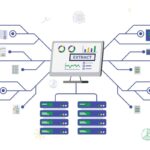B2B data scrubbing is a crucial data operation that involves finding and correcting inaccurate, inconsistent, duplicate, or outdated business data. This ensures that all available business data is updated and error-free.
B2B data scrubbing is a crucial data operation that involves finding and correcting inaccurate, inconsistent, duplicate, or outdated business data. This ensures that all available business data is updated and error-free.
Contents
- What is data scrubbing?
- Why different industries need data scrubbing?
- Role of data scrubbing in ensuring quality
- The difference between data cleaning and data scrubbing
- The need for data scrubbing in B2B databases
- Data scrubbing in B2B data
- Use data scrubbing tools or choose custom data scrubbing services – which is better?
- How AI and ML will affect the future of B2B data scrubbing
- Conclusion
In most cases, businesses are held back from using the potential of their data, and going fully data driven, because their data is not clean enough.
In fact, a survey by Experian found that companies believe about one-third of their data is inaccurate. On top of this high data inaccuracy, consider that data of B2B companies decays at a rate of 35% annually; and it becomes clear that B2B data aggregators who provide cleaner data will have a competitive edge.
This is why data aggregators devote a major part of their core resources in maintaining data accuracy, integrating data from diverse systems, and in data cleansing and scrubbing.
But, given the speed and ever-increasing volumes of business data flowing in, no B2B data aggregator can ever have enough expert staff and resources to ensure clean data across all of its databases.
Specialized B2B data cleansing companies play a key role here, helping to scrub, clean, validate, enrich, and put B2B data into shape for business use. In this article we have put together a guide for a comprehensive look at this key process of cleaning data – data scrubbing.
What is data scrubbing?
Data scrubbing, also known as data cleansing, is the process of identifying and correcting inaccurate, incomplete, or inconsistent data within a dataset. It ensures that data is reliable, high-quality, and error-free, making it more valuable for business intelligence, analytics, and decision-making.
The data scrubbing process involves:
- Detecting Errors: Identifying duplicate records, missing values, incorrect formats, and outdated information.
- Correcting Data: Standardizing formats, filling in missing values, and eliminating inconsistencies.
- Removing Duplicates: Merging or eliminating redundant entries to maintain data integrity.
- Validating Data: Ensuring that data meets predefined quality standards and aligns with business rules.
By implementing robust data scrubbing techniques, organizations can improve the accuracy of their databases, enhance operational efficiency, and gain meaningful insights from their data.
Why different industries need data scrubbing?
Data scrubbing is essential for maintaining the quality and accuracy of databases across various industries. Here are some industry-specific use cases and statistics that highlight the importance of data scrubbing:
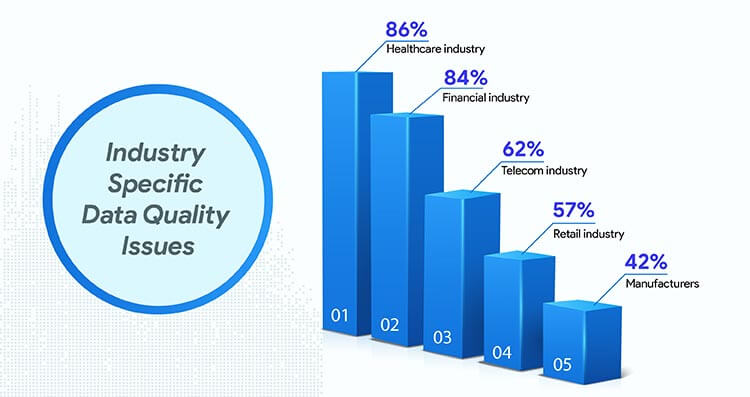
- Healthcare: Inaccurate patient data can lead to incorrect diagnoses, treatment plans, and billing issues. A study by the Ponemon Institute found that 86% of healthcare providers experienced data quality issues, leading to an average annual cost of $1.2 million per organization.
- Finance: Financial institutions rely on accurate data for risk assessment, fraud detection, and regulatory compliance. A report by Experian revealed that 84% of financial services companies experienced data quality issues, impacting their ability to make informed decisions.
- Retail: Retailers use data scrubbing to maintain accurate product information, customer data, and inventory levels. According to a study by BigCommerce, only 57% give importance to data quality. Others mention poor product and consumer data quality costs them $3.1 trillion annually.
- Telecommunications: Telecom companies need accurate customer data for billing, customer service, and network planning. A study by Gartner found that poor data quality costs telecom companies an average of $14.2 million per year.
- Manufacturing: Manufacturers rely on accurate data for supply chain management, production planning, and quality control. A report by Aberdeen Group revealed that 42% of manufacturers experienced data quality issues, leading to increased operational costs and reduced efficiency.
In conclusion, data scrubbing is vital for maintaining the accuracy and quality of databases across various industries, directly impacting their decision-making, customer satisfaction, and overall business success.
Poor data quality costs businesses $9.7M every year.
Find out how to combat cost of bad data »Role of data scrubbing in ensuring quality of B2B databases
Data scrubbing, a term often used interchangeably with data cleansing, aims to improve the quality of data. For B2B companies, where decisions are driven by data, it’s one of the key processes used to clean and refine the data and turn it into a valuable asset.
Here are the objectives of B2B data scrubbing:
- The primary aim of B2B data scrubbing is to enhance customer data quality. Poor data quality can lead to misguided strategies, missed opportunities, and financial losses.
- On the other hand, the impact of high-quality data is profound, leading to better informed decisions and in gaining a competitive edge.
- B2B data scrubbing aims at de-duplicating databases, ensuring that businesses don’t waste resources on redundant data.
- Moreover, scrubbed data ensures smoother data integration and transformation in the ETL (Extract, Transform, Load) process.
Data scrubbing is not just a onetime task, but an ongoing commitment to data quality improvement. For businesses in the B2B sector, understanding the importance of data scrubbing and integrating it diligently into their operations can be the difference between success and stagnation.
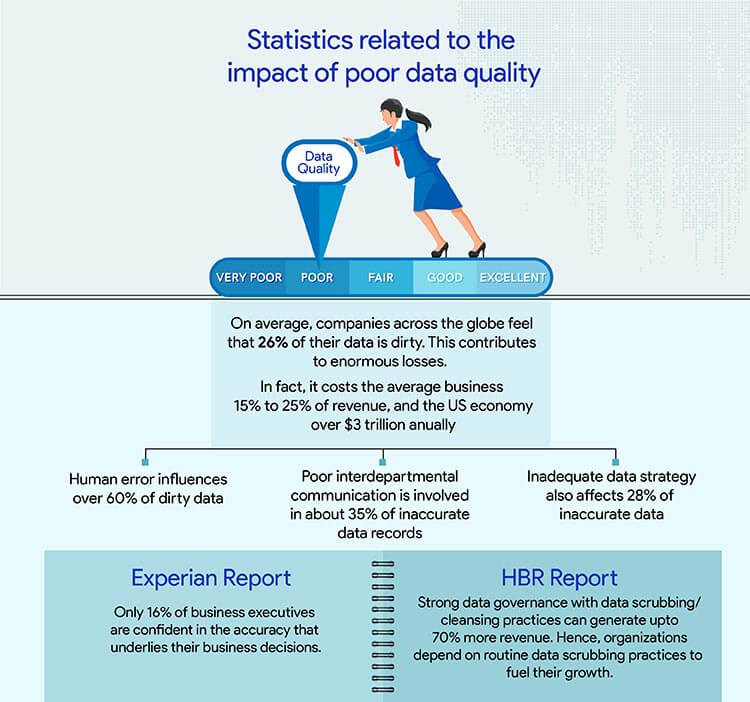
The difference between data cleaning and data scrubbing
‘Data cleaning’ and ‘data scrubbing’ have technical differences, despite being used interchangeably. Data cleaning is a broader term that encompasses all activities involved in preparing analytics-ready data, and it includes the process of data scrubbing.
Data scrubbing is actually a sub-process of data cleaning. It focuses on removing data inconsistencies, ensuring proper formatting, and validating data accuracy.
| Data Cleaning | Data Scrubbing |
| Data cleaning is the broader term for preparing analytics-ready data. | Data cleaning is the broader term for preparing analytics-ready data. |
| Data cleaning aims to correct spellings, add missing values, or eliminate invalid data, removing data inconsistencies and ensuring proper formatting. | Data scrubbing involves repairing, deleting, or normalizing data, making it more accurate and consistent, aligned with a standard. |
| Data cleaning refers to the overarching stage of fixing or removing incorrect, corrupted, incorrectly formatted, duplicate, or incomplete data within a dataset. | Data cleaning refers to the overarching stage of fixing or removing incorrect, corrupted, incorrectly formatted, duplicate, or incomplete data within a dataset. |
The need for data scrubbing for B2B companies
B2B data stands as the backbone of strategic decision-making, customer relationship management, and overall business growth. However, the sheer volume and complexity of B2B data make it susceptible to inconsistencies, inaccuracies, and redundancies. This is where data scrubbing in B2B databases becomes important. Data scrubbing serves the following needs:
- Data Accuracy: In the B2B landscape, decisions often involve substantial financial implications. Ensuring data accuracy provides a reliable foundation for these critical decisions, minimizing risks and maximizing opportunities.
- Data Consistency: With data often sourced from multiple channels in B2B operations, consistency becomes crucial. It guarantees that, irrespective of the source, the data remains uniform, facilitating seamless data analysis and interpretation.
- Data Completeness: Incomplete data can lead to incomplete insights. By filling in the gaps, businesses get a holistic view, enabling them to understand market trends, customer behaviors, and potential opportunities comprehensively.
- Data Relevance: The dynamic nature of the B2B market means data can quickly become obsolete. Removing outdated or irrelevant data ensures that businesses base their strategies on current and applicable information.
- Data Integrity: As data travels through various systems and undergoes multiple transformations, its integrity faces compromise. Ensuring data integrity means that the data remains trustworthy and of high quality throughout its lifecycle.
- Duplicate Removal: Redundant data not only consumes unnecessary storage, but can also skew analytical results. By eliminating duplicates, businesses ensure that their insights are based on unique and accurate data points.
- Error Correction: Human errors, system glitches, or integration issues can introduce anomalies in the data. Identifying and rectifying these errors is essential to maintain the credibility of the database.
- Standardization: Especially in global B2B operations, data might come in various formats and structures. Standardizing this data ensures that it adheres to a common format, making integration and analysis more streamlined.
- Validation: This step ensures that the data aligns with predefined criteria or standards, further enhancing its reliability and relevance for business operations.
- Data Security: Given the sensitive nature of B2B data, which might include trade secrets, contract details, or financial information, its security during the scrubbing process is vital. Proper scrubbing practices ensure that data remains protected against unauthorized access or potential breaches.
Benefits of data scrubbing for B2B data aggregators
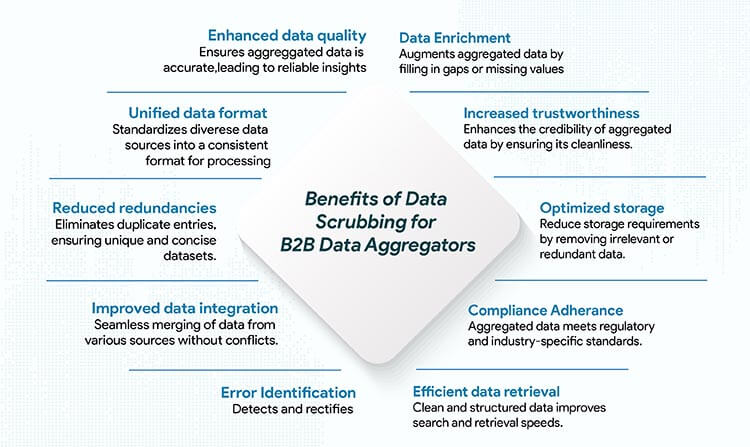
Do you want to reap the benefits of B2B data scrubbing?
Contact us right away »Data scrubbing in B2B data
As businesses recognize the significance of managing data quality, strategies on how to employ data scrubbing effectively are becoming central to their operations.
Explore the intrinsic aspects of data scrubbing of B2B data, as we outline the datasets, best practices for scrubbing data, an effective workflow, and the best tools involved.
Types of B2B data that would require scrubbing
There are several types of B2B data that often require scrubbing due to their propensity for errors and inconsistencies. These include:
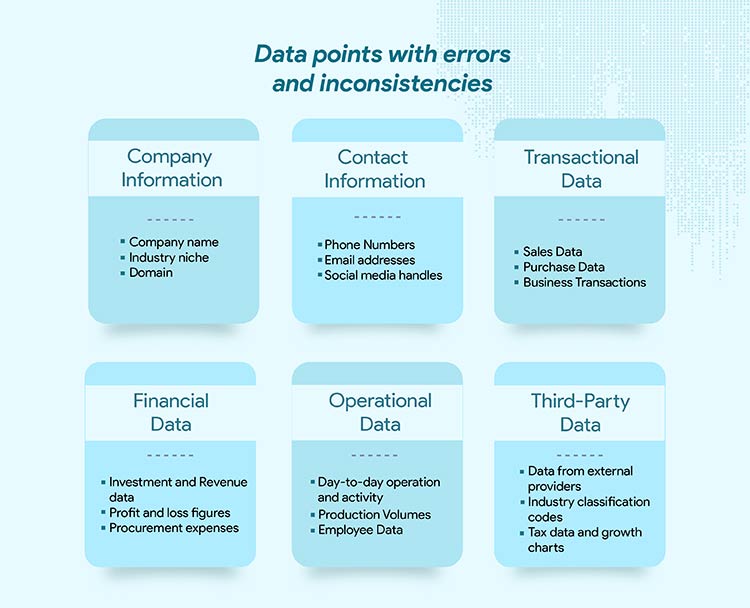
With regular data scrubbing, you can keep your B2B data clean, accurate, and ready for action.
Effective data scrubbing best practices for B2B companies
In B2B operations, data provides the base for decision-making and strategic planning. However, the value of this data is only as good as its quality, making data scrubbing an essential practice. So, how to perform data scrubbing? The process begins with assessing the current state of the data, identifying errors, and planning a plan for rectification.
Cleaning the database is just one aspect; maintaining its cleanliness is equally crucial. This calls for data scrubbing best practices, which include regular audits, employing data validation techniques, and continuous monitoring.
The following best practices can make B2B data scrubbing not just effective but also efficient:
- Identify data quality issues: The first step in any data scrubbing process is identifying the existing issues. In B2B databases, these could range from multiple entries for the same company due to naming variations to outdated contact information. One example is when “Acme Corp.” and “Acme Corporation,” listed as separate entities, cause data duplication and errors.
- Define data quality rules: Once we identify the issues, the next step is to establish rules for data quality. These rules could involve standardizing naming conventions, address formats, or even validating email structures. For example, we could standardize all variations of a company’s name to “Acme Corporation” to maintain consistency.
- Cleanse and standard data: Armed with defined rules, the actual cleaning process begins. This involves merging duplicate records, standardizing names, and updating any outdated or incorrect information. The aim is to bring all data in line with the established quality rules.
- Remove duplicates: Duplicate entries can severely compromise the quality of B2B data. Identifying and merging these duplicates is crucial. For example, if “Acme Corporation” appears twice but with different contact details, they should merge these entries into a single, accurate record.
- Handle missing data: Incomplete data can lead to incomplete insights. We should fill missing data in from reliable sources, such as trusted third-party data providers, to ensure that the database is comprehensive and useful for analysis.
- Address inconsistencies: B2B data often comes from multiple sources, leading to inconsistencies. For instance, one system might record revenue in thousands, while another does it in millions. Such inconsistencies need to be identified and standardized to maintain data accuracy.
- Document data scrubbing process: Transparency and documentation are key to any successful data scrubbing process. Documenting the rules and procedures not only serves as a guide for future scrubbing but also aids in training new staff members, ensuring that the process remains consistent.
- Regularly monitor and update: B2B data is not static; it’s dynamic and ever-changing. Regular monitoring and updating are essential to ensure that the data remains accurate and reliable. For example, if a company changes its contact information, update the database accordingly.
- Documentation (Reiteration): Documenting the data scrubbing process serves as a blueprint for maintaining data quality and provides a basis for continuous improvement.
The B2B data scrubbing process – a workflow
Scrubbed data helps you streamline your sales strategy by ensuring the quality of sales data. As a result, you can move away from everyday operations of administering and updating the data and spend more time on core engagements like sales strategizing, networking and selling.
Some fundamental steps to scrub your data:
Data assessment
Begin by analyzing the current state of the data to identify inconsistencies, errors, and areas of improvement.
Validation of data
Implement checks to ensure that the data meets predefined criteria, confirming its accuracy and relevance.
Removal of duplicate records
Scan the dataset to identify and eliminate any redundant or repeated entries, ensuring data uniqueness.
Removal of inactive records
Identify and discard records that are outdated, irrelevant, or no longer in use to maintain data’s current relevance.
Formulation of SOPs (Standard Operating Procedures)
Develop clear and standardized guidelines detailing how data scrubbing should be conducted to maintain consistency.
Process setup
Establish a systematic workflow for data scrubbing, incorporating tools, software, and manual checks.
Continuous monitoring and maintenance
Regularly review and update the scrubbing process to adapt to changing data needs and ensure ongoing data quality.
Empower your data quality strategies with the right data cleansing practices.
Check out this expert data cleansing tips »Top 5 data scrubbing tools
Various data scrubbing tools are available in the market, each designed to address a range of specific challenges. However, it’s essential to choose tools that align with a business’s unique needs. Let’s meet the top five data scrubbing tools that make the process smoother than ever.

1. Hevo data
Hevo Data is a comprehensive no-code data pipeline platform designed to facilitate the integration of data from multiple sources. It specializes in cleaning and transforming diverse datasets to make them ready for analysis. It enables businesses to integrate data from multiple sources and to clean and transform diverse datasets. This makes the data analysis-ready and structured, which is particularly useful for businesses dealing with varied data types.
2. Winpure
Winpure is a dedicated data quality management tool designed to address common data quality issues, such as duplicate data and inconsistencies in large datasets. It is adept at correcting and standardizing information across diverse datasets, ensuring uniformity and accuracy. It is beneficial for businesses looking to maintain high data quality standards by eliminating redundancies and standardizing information.
3. Cloudingo
Cloudingo is a specialized tool designed for Salesforce users, focusing on optimizing data within the Salesforce environment. It offers features like data migration and duplicate deletion, aiming to reduce human errors in data management processes. It is essential for Salesforce users seeking to maintain optimal data quality and integrity within their CRM systems.
4. Trifacta Wrangler
Trifacta Wrangler is a robust data management tool aimed at optimizing the time spent on data formatting and analysis. It employs advanced machine learning algorithms to recommend common data transformations and aggregations, streamlining the data preparation process. It is ideal for businesses and individuals looking to reduce the time and effort spent on preparing data for analysis, allowing for a more efficient data analysis process.
5. Data Ladder
Data Ladder stands out for its speed and precision in managing data quality. It offers a user-friendly interface that enables users to clean, match, and deduplicate data efficiently. Known for its rapid processing capabilities and accurate results, Data Ladder is suitable for businesses and individuals who prioritize speed and accuracy in their data management tasks, ensuring high-quality, reliable data.
These data scrubbing tools are the superheroes you need in your data management strategy. With their unique capabilities, they can help you transform your data from a messy pile into a clean, structured, and valuable asset.
Use data scrubbing tools or choose custom data scrubbing services – which is better?
For unique business needs, custom data scrubbing service offerings may be better than off-the-shelf data scrubbing tools. It is useful to know when to opt for a ready tool available in the market, and when to opt for a customized one.
Generic Data Scrubbing Tools: These are ready-made software solutions designed to cleanse and enhance data quality. They come with predefined algorithms and methods to detect and rectify common data issues. Their primary advantage lies in their broad applicability and ease of use.
Custom Data Scrubbing Solutions: These are tailored solutions, often provided by specialized firms, designed to address specific data challenges faced by businesses. Their strength lies in their adaptability, precision, and depth.
Here are the major advantages of custom data scrubbing:
- Tailored Solutions: Every business is unique, and so is its data. Generic tools cannot cater to individual B2B data challenges. Custom scrubbing, on the other hand, recognizes these nuances and offers solutions that are tailored to each business’s unique needs.
- Flexibility: As businesses grow, so do their data needs. Custom services can adapt to these changing requirements, ensuring that the data remains relevant and accurate, without the constraints typical of generic tools.
- Integration Capabilities: B2B operations often involve proprietary systems and databases. Custom scrubbing services can seamlessly integrate with these systems, ensuring smooth data processing and minimal disruption.
- Focused Accuracy: While generic tools address broad data issues, custom services can hone in on specific B2B data anomalies, ensuring a more refined and accurate database.
- Scalability: Whether it’s a surge in data volume or increased complexity, custom solutions can scale accordingly, ensuring consistent data quality.
- Cost Efficiency: While the initial investment might be higher, in the long run, custom services can prove more cost-effective. They address precise needs, eliminating the cost of unnecessary features typical of generic tools.
- Enhanced Security: B2B data often contains sensitive information. Custom scrubbing services can adhere to specific security protocols, ensuring robust data protection against potential breaches.
- Continuous Improvement: One of the standout features of custom services is their ability to evolve. These solutions can iteratively improve based on feedback and changing business landscapes, ensuring that they remain innovative.
HabileData’s Edge: HabileData provides custom solutions for data scrubbing due to their extensive expertise. Their specialized knowledge, combined with a tailored approach, ensures superior data quality. Companies looking for precise and excellent data management prefer them due to their experience.
Do you want your data scrubbed with a tailored approach?
Drop in a line today »How AI and ML will affect the future of B2B data scrubbing
Artificial Intelligence (AI) and Machine Learning (ML) are emerging as transformative forces. Their potential to redefine various sectors is immense, and B2B data scrubbing is no exception. As businesses grapple with ever-increasing volumes of data, they deem traditional methods of data cleaning insufficient. Enter AI and ML, which promise not just efficiency but also unparalleled accuracy in the realm of data scrubbing. Let’s dive deeper into how these technologies will reshape the future of B2B data scrubbing:
- Pattern Recognition: One of the standout capabilities of machine learning is its ability to discern patterns in vast datasets. By analyzing patterns, ML algorithms can quickly find mistakes that humans might miss. This not only ensures data accuracy, but also provides insights into underlying data trends, which can be invaluable for businesses.
- Automated Cleaning: Manual data scrubbing, especially for large B2B databases, can be time-consuming and prone to errors. AI-driven algorithms can automate the data cleaning process, ensuring efficient and effective results. Using AI algorithms for data cleaning improves accuracy and reduces human error.
- Predictive Cleaning: Machine learning, with its predictive capabilities, allows businesses to be one step ahead. By analyzing historical data patterns, ML can forecast potential errors or inconsistencies in new data. This means businesses can proactively address data issues even before they manifest, ensuring that their databases remain pristine.
- Duplicate Detection: Duplicates are a recurring challenge in B2B databases. They can skew analytical results and misguide strategies. Advanced AI algorithms can sift through vast datasets, identifying and eliminating duplicate entries with unparalleled precision. This not only enhances data quality but also ensures consistency, which is crucial for accurate data analysis.
The Road Ahead: As AI and ML technologies continue to mature, their impact on B2B data scrubbing will only intensify. They promise a future where data cleaning is not just efficient but also a predictive and proactive process. For businesses, this means access to cleaner, more accurate data, which can drive informed decision-making and strategic growth.
Conclusion
The significance of data scrubbing in refining B2B data quality is important for our informed decision-making and business growth. We need to follow meticulous processes in data scrubbing to overcome challenges and find suitable solutions. Machine learning and data validation play a crucial role in this process. Consider using standard or custom data scrubbing tools to ensure continuous improvement.
At HabileData, we fully leverage data scrubbing practices and tools to enhance data quality and drive better business outcomes. We understand that in today’s complex business landscape, clean, accurate, and reliable data is not just a luxury, but a necessity. And we ensure that we scrub your B2B data clean of errors and inconsistencies, ready to provide valuable insights for decision-making.
As we move forward in this data-driven era, the importance of data scrubbing will only continue to grow. Because, by effectively scrubbing our data, we can transform it into a valuable asset, ensuring accuracy and reliability for better strategic outcomes.
Dirty data is responsible for majority of enterprise costs.
Get your data cleaned today »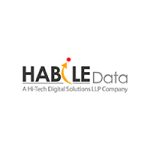
HabileData is a global provider of data management and business process outsourcing solutions, empowering enterprises with over 25 years of industry expertise. Alongside our core offerings - data processing, digitization, and document management - we’re at the forefront of AI enablement services. We support machine learning initiatives through high-quality data annotation, image labeling, and data aggregation, ensuring AI models are trained with precision and scale. From real estate and ITES to retail and Ecommerce, our content reflects real-world knowledge gained from delivering scalable, human-in-the-loop data services to clients worldwide.



